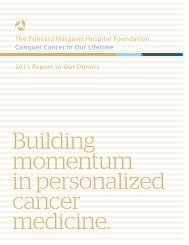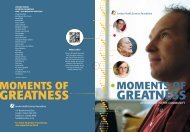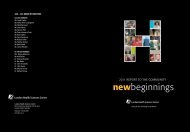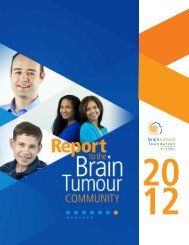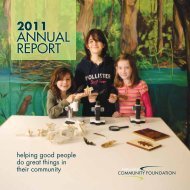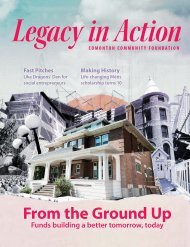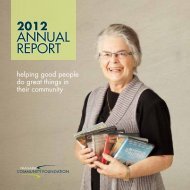2011 Donor Impact Report - Charity Focus
2011 Donor Impact Report - Charity Focus
2011 Donor Impact Report - Charity Focus
- No tags were found...
You also want an ePaper? Increase the reach of your titles
YUMPU automatically turns print PDFs into web optimized ePapers that Google loves.
Helping people to breathe easyFor some, an asthma attack can be life threatening.“The challenge we face iswhat happens when patientsdon’t respond to traditionaltreatments for asthma,” saidDr. Richard Leigh.People with asthma areencouraged to make lifestylechanges that prevent attacksbut avoiding a common coldisn’t that easy.For Dr. Leigh and his teamof researchers, the airway isinstrumental in understandingthe role of the commoncold in asthma and chronicobstructive pulmonary disease(COPD), a term which includeschronic bronchitis andemphysema. “We know thatindividuals who frequently getcolds develop scarring in theirbronchial tubes and this is animportant factor in causingtheir airways to constrict toomuch and too frequentlyin response to allergens,”explained Dr. Leigh. He refersto this as ‘airway remodelling.’Working with Calgary HealthTrust, a private donor madea four year donation of$200,000 to the AirwayInflammation Research Groupat the University of Calgary.The money has helped Dr.Leigh’s team to understandwhat happens to the airwaywhen getting a cold, helpingYour impact20 Calgary Health Trustthem create their ownHistology Tissue Core Facilityto look specifically at thecells in the airway. It will alsobe instrumental in identifyingwhich antiviral molecules aremost relevant and how theycan be enhanced.Most recently, the teampurchased a programmablerobot to assist in theirresearch. A study, led byDr. Leigh’s co-worker,Dr. Robert Newton, will usethe robot to look at hundredsof genes at one time andhelp to better understandhow commonly used asthmamedications work in the body.Doing so will allow the teamto radically improve existingtreatments, but also identifypotential new pathwaysto develop new asthmatreatments. “This robot is aradical game changer for us,”said Dr. Newton. “We are nowable to accomplish in a fewmonths what previously wouldhave taken us many years,putting us much closer toidentifying genes that respondwell to antiinflammatorymedication.”This research will substantially16 minutesadvance treatment for asthmaand COPD.How this research will impact acute careAsthma and chronicobstructive pulmonary disease(COPD), including bronchitisand emphysema are two ofthe most common chronicdiseases in the world, affectingapproximately 3.5 millionCanadians.In Alberta, someone havingan asthma attack visits the(Top) Researchers are able to isolate and examine individualmolecules in the airway. (Bottom) The robot allows for multiplegenes to be examined at once, saving years in the study.emergency room every 16minutes with symptoms thatthey cannot control throughtraditional medicine. Acuteasthma attacks account forhalf of the total health carecosts for this disease andare the most frequent causeof hospitalization in pediatricpopulations in developedcountries.Identifying the molecules that are most important will helpDr. Leigh, Dr. Newton and their team substantially advancethe treatment for asthma and COPD.“If we can identify which moleculesmatter the most in severe cases, thenwe can adjust traditional medicine tohelp more people with asthma.”– Dr. Richard LeighAcute attacks of COPDaccount for 3 per cent of allhospitalizations and 70 percent of health care costs forCOPD. The average hospitalstay for someone admittedbecause of an attack is 14days due to current treatmentswith a 25 per cent failure rate.Dr. Leigh and Dr. Newton’sresearch is looking for waysto significantly decreasethese numbers.





